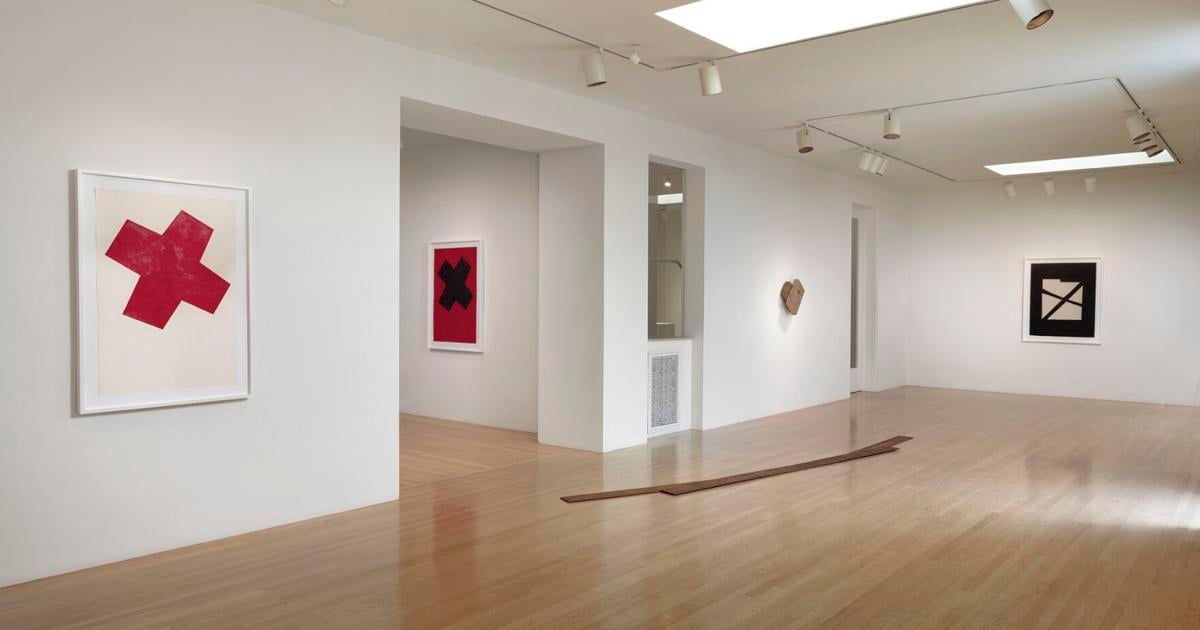The art world continuously strives for innovation while honoring its foundational figures. L.A. Louver’s latest exhibition achieves this delicate balance. The Venice gallery’s latest exhibition, featuring the sculptures and paintings of the late artist Richard Nonas, a pivotal figure in contemporary art, is on view through Saturday, July 20. Nonas’s work bridges the gap between Minimalism and Post-Minimalism, exploring the complex relationship between material, space, and environment. This exhibition not only showcases his key preoccupations but also highlights an important transition in art history.
“(The gallery) had shown and collected Richard’s work before,” said Kimberly Davis, director of L.A. Louver and curator of the show, reflecting on a relationship that dates back to the mid-70s. “He was someone who was always with us, and we had admired and bought some of his work.” The last exhibition showcasing Nonas’s work celebrated the gallery’s 45th anniversary shortly after the artist’s passing.
Many of the works were sourced from Nonas’ studio, which was “completely sustained as if he had just walked out the door,” Davis explained. His studio offered a glimpse into his life — one of simplicity yet richness, characterized by handmade kitchen tools, beautiful kayak boats and countless books lining the walls. “It was such a rich experience, both in terms of describing his life and exploring his work,” Davis said. The gallery was given free rein to explore and select pieces for the exhibit.
The exhibit spans works from the 1980s to 2014, featuring pieces crafted from steel and wood.
“They’re very simple forms but very dense and intense,” Davis said.
The exhibit includes five never-before-seen paintings on paper and sculptures crafted from wood and steel, carefully chosen to highlight the elegance and raw power of Nonas’ minimalist approach.
Nonas was born in New York in 1936 and passed away in the same city in 2021. He studied literature and social anthropology at the University of Michigan, Lafayette College, Columbia University, and the University of North Carolina. Nonas transitioned to sculpture in the mid-1960s after a career in anthropology. In the 1970s, he was part of a pioneering group of artists and curators who sought alternative exhibition spaces, including the inaugural exhibition at P.S.1 (now MoMA PS1) in 1976.
Nonas holds a significant place in the world of minimalist sculpture. His work, celebrated throughout Europe and in the United States, has a universal appeal due to its simplicity and power. “It’s all about redefining a sense of space around you,” Davis explained. Nonas’s background in anthropology heavily influenced his artistic vision, allowing him to create pieces that encourage viewers to perceive their surroundings in new and profound ways. “The works allow you just to be very focused on the power and the elegance that they have,” Davis added. His works are raw yet elegant, offering a calm and introspective experience for those willing to engage deeply.
“For people who know the work, (the reception) has been fantastic,” Davis shared. Even for newcomers, the exhibit offers a transformative experience. “Standing with the works and being with them calms you down and allows you to see the world differently.” The exhibit challenges visitors to take their time, immerse themselves, and truly appreciate the subtle power of Nonas’s creations.
“For someone who runs up the stairs and says, ‘That’s all there is,’ they’re not going to get anything out of it, but for someone willing to take the time and look at things and think about them, then there you go,” Davis emphasized, highlighting the depth and richness of Nonas’s work. The exhibition is a representation of smaller-scale works he’s made in addition to his outdoor installations.
Before embarking on his artistic journey, Richard Nonas spent nearly a decade as an anthropologist. His fieldwork, particularly with the Tohono O’odham people in Mexico, profoundly influenced his artistic practice. Nonas observed how these communities derived meaning from interacting with objects within their landscape. This experiential relationship became the cornerstone of Nonas’s work, emphasizing the significance of physical objects as spatial markers.
Nonas’ sculptures are crafted from found materials such as wood, stone and metal, often bearing the marks of their histories. These aesthetic imperfections set his work apart from the intentional simplicity of artists like Donald Judd and align him more closely with Richard Serra. Nonas’ focus on site specificity created a dynamic interaction between object, actor and location. His constructions charged the surrounding space with potential energy, using space as an active material shaped by the imposition of physical objects. In various contexts, Nonas sourced sculptural materials from the surrounding landscape, reinterpreting the environment of the exhibition space.
The exhibit also features Nonas’s paintings on paper. These paintings serve as iconic descriptions of his sculptures, graphically rendered in a highly pigmented palette of red, black and white. The figure-ground relationship in these works is deliberately confused, emphasizing the equality between shape, line and surrounding space in constructing an environment.
Despite the necessity of interaction, Nonas intentionally left the relationship between the viewer, sculpture and environment ambiguous. This ambiguity, facilitated by the geometric nature of his works, allows for philosophical and emotional contemplation of existence within a matrix of context and history. Nonas’s works are not mere representations of the past or future but provocations that heighten awareness of the present.

